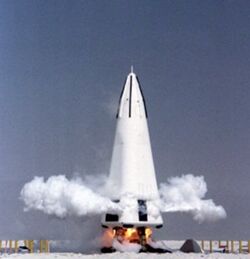Engineering:List of McDonnell Douglas DC-X launches
Between 1993 and 1996, the McDonnell Douglas DC-X, also known as the "Delta Clipper", conducted twelve low-altitude suborbital test launches to verify the configuration and handling of the uncrewed single-stage-to-orbit Delta Clipper design, which was proposed to the United States Department of Defense and the National Aeronautics and Space Administration (NASA) for use as a reuseable launch vehicle.[1] Claimed as the first rocket to conduct a vertical landing on Earth, the DC-X was a one-third scale demonstrator for the proposed operational Delta Clipper vehicle.[2]
After the first three flights Strategic Defense Initiative Organization funding for the test project was cancelled;[3] the remaining test program was conducted by NASA and the Advanced Research Projects Agency.[4] Following the eighth test flight, the vehicle was transferred fully to NASA and the vehicle was modified to DC-XA configuration,[5] also known as "Clipper Graham" after General Daniel O. Graham who had died in 1995 after supporting the Delta Clipper project.[6]
Of the overall test program, ten of the vehicle's launches were fully successful; the fifth test flight was aborted early in the flight following an on-board explosion but the vehicle was successfully recovered. The twelfth and final flight saw one of the vehicle's landing legs fail to extend; on landing, when the vehicle tipped over onto its unsupported corner, a liquid oxygen tank ruptured and exploded, the ensuing fire destroying the modified DC-XA vehicle and ending the program. Despite the loss the program was considered overall to have been a success.[1]
Launch history
| Flight No. | Date and time of takeoff (UTC) | Vehicle | Launch site | Suborbital apogee | Outcome | Duration | Reference |
|---|---|---|---|---|---|---|---|
| 1 | 18 August 1993 23:43 |
DC-X | White Sands Space Harbor | 46 m (151 ft) | Success | 59 sec | [7] |
| Control system and vertical landing capability test.[7] Demonstrated hovering ability and 350 foot (110 m) horizontal translation.[6] | |||||||
| 2 | 11 September 1993 18:12 |
DC-X | White Sands Space Harbor | 92 m (302 ft) | Success | 66 sec | [7] |
| Ground effects and ascent-and-landing mode control test.[7] | |||||||
| 3 | 30 September 1993 17:30 |
DC-X | White Sands Space Harbor | 370 m (1,210 ft) | Success | 72 sec | [7] |
| Aerostability test; vehicle conducted 180° roll.[7] | |||||||
| 4 | 20 June 1994 15:42 |
DC-X | White Sands Space Harbor | 870 m (2,850 ft) | Success | 2 min 16 sec | [7] |
| First flight with fully loaded propellant tanks and operational radar altimeter.[7] | |||||||
| 5 | 27 June 1994 15:37 |
DC-X | White Sands Space Harbor | 790 m (2,590 ft) | Partial failure | 78 sec | [7] |
| Flight aborted after hydrogen explosion on launch; autoland capabilities demonstrated.[7] | |||||||
| 6 | 16 May 1995 16:40 |
DC-X | White Sands Space Harbor | 1.33 km (0.83 mi; 4,400 ft) | Success | 2 min 4 sec | [7] |
| Flight envelope expansion test.[7] | |||||||
| 7 | 12 June 1995 15:38 |
DC-X | White Sands Space Harbor | 1.74 km (1.08 mi; 5,700 ft) | Success | 2 min 12 sec | [7] |
| AOA envelope expansion, first reaction control system usage.[7] | |||||||
| 8 | 7 July 1995 14:02 |
DC-X | White Sands Space Harbor | 2 km (1.2 mi; 6,600 ft) | Success | 2 min 4 sec | [7] |
| Turnaround maneuver demonstrated; hard landing resulted in damage to the aeroshell.[7] | |||||||
| 9 | 18 May 1996 15:14 |
DC-XA | White Sands Space Harbor | 244 m (801 ft) | Success | 62 sec | [7] |
| First flight following modification to DC-XA configuration; slow landing resulted in aeroshell fire.[7] | |||||||
| 10 | 7 June 1996 17:15 |
DC-XA | White Sands Space Harbor | 590 m (1,940 ft) | Success | 64 sec | [7] |
| Maximum structural stress test.[7] | |||||||
| 11 | 8 June 1996 19:17 |
DC-XA | White Sands Space Harbor | 3.14 km (1.95 mi; 10,300 ft) | Success | 2 min 22 sec | [7] |
| Demonstration of 26-hour rapid turnaround; altitude and duration record set.[7] | |||||||
| 12 | 31 July 1996 20:15 |
DC-XA | White Sands Space Harbor | 1.25 km (0.78 mi; 4,100 ft) | Partial success | 2 min 20 sec | [7] |
| Successful maneuvering test; vehicle destroyed on landing when landing strut failed to extend and LOX tank exploded.[7][8] | |||||||
References
- ↑ 1.0 1.1 McLaughlin, Hailey Rose (29 October 2019). "DC-X: The NASA Rocket That Inspired SpaceX and Blue Origin". Kalmbach Publishing. https://www.discovermagazine.com/the-sciences/dc-x-the-nasa-rocket-that-inspired-spacex-and-blue-origin.
- ↑ "Rocket has good test flight". Tampa. 20 August 1993. https://www.tampabay.com/archive/1993/08/20/rocket-has-good-test-flight/.
- ↑ Burdick, Alan (7 November 1993). "Pie In The Sky?". The New York Times (New York): pp. 6–46. https://www.nytimes.com/1993/11/07/magazine/pie-in-the-sky.html.
- ↑ "Delta Clipper Test Program Off To Flying Start". McDonnell Douglas via NASA. 20 June 1994. http://www.hq.nasa.gov/pao/History/x-33/dcxtests.html#flight4. Retrieved 21 December 2020.
- ↑ "Will The Delta Clipper Scuttle The Shuttle?". New York. 8 July 1996. https://www.bloomberg.com/news/articles/1996-07-07/will-the-delta-clipper-scuttle-the-shuttle.
- ↑ 6.0 6.1 Lerner, Preston (August 2010). "Black Day at White Sands". Smithsonian Institution. https://www.airspacemag.com/space/black-day-at-white-sands-1381694/.
- ↑ 7.00 7.01 7.02 7.03 7.04 7.05 7.06 7.07 7.08 7.09 7.10 7.11 7.12 7.13 7.14 7.15 7.16 7.17 7.18 7.19 7.20 7.21 7.22 7.23 Sorensen, Kirk (26 December 2012). "The Delta Clipper Experimental: Flight Testing Archive". in Andrew J. Butrica. NASA. https://www.hq.nasa.gov/pao/History/x-33/dc-xa.htm. Retrieved 20 December 2020.
- ↑ Norris, Guy (6 August 1996). "Clipper flight ends in disaster". FlightGlobal. https://www.flightglobal.com/clipper-flight-ends-in-disaster/6253.article. Retrieved 20 December 2020.
 |


